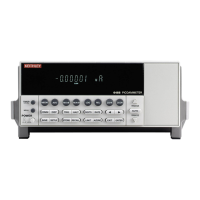Model 6485 Picoammeter Instruction Manual Buffer 6-5
NOTE If any readings stored in the buffer are the result of an overflow or overvoltage
condition, the buffer statistics calculation will not be performed. Buffer recall
via front panel operation will show a series of dashes in place of the requested
buffer statistics value. In remote operation, the corresponding buffer statistics
will be represented by the value +9.91e37.
SCPI programming
Commands associated with buffer operation are listed in Table 6-1. The TRACe com-
mands are used to store and recall readings in the buffer. The FORMat:ELEMents com-
mand is used to specify which data elements to include in the response message for
TRACe:DATA? (which is the command to read the buffer). The CALCulate3 commands
are used to obtain statistics from the buffer data.
NOTE The Model 6485 uses IEEE-754 floating point format for statistics calculations.
Table 6-1
SCPI commands — buffer
Commands Description Default Ref
:TRACe
:CLEar
:FREE?
:POINts <n>
:ACTual?
:FEED <name>
:CONTrol <name>
:TSTamp
:FORMat <name>
:DATA?
:FORMat
:ELEMents <list>
:CALCulate3
:FORMat <name>
:DATA?
TRACe Subsystem:
Clear readings from buffer.
Query bytes available and bytes in use.
Specify number of readings to store; 1 to 2500.
Returns number of readings actually stored in buffer.
Select source of readings; SENSe[1], CALCulate[1] or
CALCulate2.
Select buffer control mode; NEVer or NEXT.
Timestamp:
Select timestamp format; ABSolute or DELTa.
Read all readings in buffer.
FORMat Subsystem:
Specify data elements for :TRACe:DATA? response
message; READing, UNITs, TIME and STATus. On
*RST or SYSTem:PRESet, resets to default values.
CALCulate3 Subsystem:
Select buffer statistic; MINimum, MAXimum, MEAN,
SDEViation or PKPK.
Read the selected buffer statistic.
See Note
100
SENS1
NEV
ABS
All 4
MEAN
A
B
C
D
E
Section 13
F
G
H
Note: SYSTem:PRESet and *RST have no effect on :TRACe commands. The listed defaults are power-on defaults.

